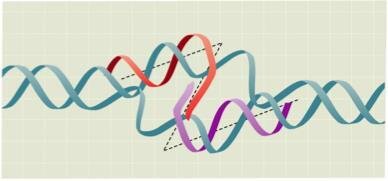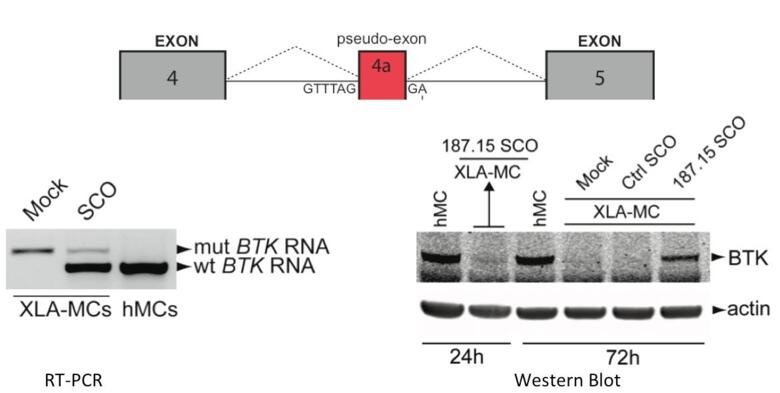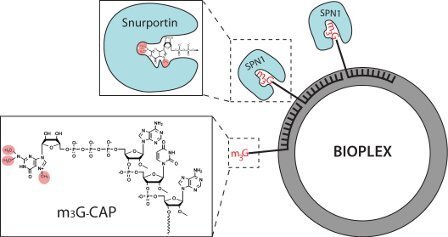Project 2: Program in Gene and Cell Therapy
One objective of our program is to develop synthetic ONs for therapy. A start-up company, Oligomer Sciences AB, is involved in the development of certain aspects of this technology. Another objective is to develop efficient methods for the study of exosomes, including the use of these extracellular vesicles as therapeutics.
Gene and cell therapies are emerging technologies with the potential of having an important impact on the future treatment of human diseases. Over the last few years, highly promising results have been obtained in patients with inherited immunodeficiencies, storage diseases, blindness, and hemophilia, just to mention a few.
Five subprojects describe this research:
1. Development of ONs with sequence-specific binding to double-stranded (ds) DNA.
The recently designed locked-nucleic acids (bisLNAs) have the capacity to strand-invade and form highly stable complexes with supercoiled DNA (Fig. 1a; Moreno et al. 2013). Another construct that we have developed, designated Zorro-LNA, has the unique feature of simultaneously hybridizing to both strands of the DNA duplex (Fig. 1b; Ge et al., 2007, Zaghloul et al., 2011). Zorro-LNAs are investigated as possible anti-gene constructs for silencing mutated genes in dominant genetic diseases.
2. Splice-switching ONs as tools to alter the processing of pre-mRNA.
We have recently been able to correct the splicing of a mutated BTK pre-mRNA, thus rescuing the production of functional BTK protein (Fig. 2; Bestas et al. manuscript in preparation). ONs were optimized in terms of sequence and chemical modifications and studied both in primary patient cells and in cells from humanized mice.
3. Nuclear transport of nucleic acids for gene therapy.
Here we have used the trimethylated Cap (m3G-Cap) as a new intranuclear transport enhancer. The m3G-Cap specifically binds to the nuclear transport protein, Snurportin and was used to ferry splice-switching ONs into the nucleus, thereby enhancing their activity (Fig. 3; Moreno et al., 2009).
4. Minicircle technology
In a study addressing the stability issue of plasmid -derived vectors we have recently highlighted the advantages of small mini-circle vectors devoid of bacterial sequences (Stenler et al., 2014).
5. Exosomes, cell-derived vesicles for transport of protein and nucleic acids.
Exosomes are vesicles naturally exported from cells into extracellular fluids. In this project we have established a new purification method to increase the yield and purity of the exosomes (Nordin et al., submitted). The possible role of exosomes in transporting signals in the form of nucleic acids or proteins between cells is currently being studied, as well as how to use exosomes as a means to transfer genetic material.




Selected references
A peptide nucleic acid-nuclear localization signal fusion that mediates nuclear transport of DNA.
Brandén LJ, Mohamed AJ, Smith CI
Nat Biotechnol 1999 Aug;17(8):784-7
Choosing CCR5 or Rev siRNA in HIV-1.
Arteaga HJ, Hinkula J, van Dijk-Härd I, Dilber MS, Wahren B, Christensson B, et al
Nat Biotechnol 2003 Mar;21(3):230-1
Zorro locked nucleic acid induces sequence-specific gene silencing.
Ge R, Heinonen JE, Svahn MG, Mohamed AJ, Lundin KE, Smith CI
FASEB J 2007 Jun;21(8):1902-14
A synthetic snRNA m3G-CAP enhances nuclear delivery of exogenous proteins and nucleic acids.
Moreno PM, Wenska M, Lundin KE, Wrange O, Strömberg R, Smith CI
Nucleic Acids Res 2009 Apr;37(6):1925-35
Non-viral nanovectors for gene delivery: factors that govern successful therapeutics.
Viola JR, El-Andaloussi S, Oprea II, Smith CI
Expert Opin Drug Deliv 2010 Jun;7(6):721-35
Formulation and delivery of splice-correction antisense oligonucleotides by amino acid modified polyethylenimine.
Zaghloul EM, Viola JR, Zuber G, Smith CI, Lundin KE
Mol Pharm 2010 Jun;7(3):652-63
Optimizing anti-gene oligonucleotide 'Zorro-LNA' for improved strand invasion into duplex DNA.
Zaghloul EM, Madsen AS, Moreno PM, Oprea II, El-Andaloussi S, Bestas B, et al
Nucleic Acids Res 2011 Feb;39(3):1142-54
Development of bis-locked nucleic acid (bisLNA) oligonucleotides for efficient invasion of supercoiled duplex DNA.
Moreno PM, Geny S, Pabon YV, Bergquist H, Zaghloul EM, Rocha CS, et al
Nucleic Acids Res 2013 Mar;41(5):3257-73
Micro-minicircle Gene Therapy: Implications of Size on Fermentation, Complexation, Shearing Resistance, and Expression.
Stenler S, Wiklander OP, Badal-Tejedor M, Turunen J, Nordin JZ, Hallengärd D, et al
Mol Ther Nucleic Acids 2014 Jan;2():e140
